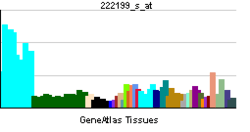Bridging integrator 3
| BIN3 | |||||||||||||||||
|---|---|---|---|---|---|---|---|---|---|---|---|---|---|---|---|---|---|
| Identifiers | |||||||||||||||||
| Aliases | BIN3 | ||||||||||||||||
| External IDs | MGI: 1929883 HomoloGene: 5472 GeneCards: BIN3 | ||||||||||||||||
| |||||||||||||||||
| RNA expression pattern | |||||||||||||||||
 | |||||||||||||||||
| More reference expression data | |||||||||||||||||
| Orthologs | |||||||||||||||||
| Species | Human | Mouse | |||||||||||||||
| Entrez | |||||||||||||||||
| Ensembl | |||||||||||||||||
| UniProt | |||||||||||||||||
| RefSeq (mRNA) | |||||||||||||||||
| RefSeq (protein) | |||||||||||||||||
| Location (UCSC) | Chr 8: 22.62 – 22.67 Mb | Chr 14: 70.1 – 70.14 Mb | |||||||||||||||
| PubMed search | [1] | [2] | |||||||||||||||
| Wikidata | |||||||||||||||||
| View/Edit Human | View/Edit Mouse |
Bridging integrator 3 is a protein that in humans is encoded by the BIN3 gene.[3][4]
Function
The product of this gene is a member of the BAR domain protein family. The encoded protein is composed solely of a BAR domain which is predicted to form coiled coil structures and proposed to mediate dimerization, sense and induce membrane curvature, and bind small GTPases. BAR domain proteins have been implicated in endocytosis, intracellular transport, and a diverse set of other processes.[4]
References
- ↑ "Human PubMed Reference:".
- ↑ "Mouse PubMed Reference:".
- ↑ Ren G, Vajjhala P, Lee JS, Winsor B, Munn AL (Mar 2006). "The BAR domain proteins: molding membranes in fission, fusion, and phagy". Microbiol Mol Biol Rev. 70 (1): 37–120. doi:10.1128/MMBR.70.1.37-120.2006. PMC 1393252
 . PMID 16524918.
. PMID 16524918. - 1 2 "Entrez Gene: BIN3 bridging integrator 3".
Further reading
- Habermann B (2004). "The BAR-domain family of proteins: a case of bending and binding?". EMBO Rep. 5 (3): 250–5. doi:10.1038/sj.embor.7400105. PMC 1299016
 . PMID 14993925.
. PMID 14993925. - Maruyama K, Sugano S (1994). "Oligo-capping: a simple method to replace the cap structure of eukaryotic mRNAs with oligoribonucleotides.". Gene. 138 (1–2): 171–4. doi:10.1016/0378-1119(94)90802-8. PMID 8125298.
- Routhier EL, Burn TC, Abbaszade I, et al. (2001). "Human BIN3 complements the F-actin localization defects caused by loss of Hob3p, the fission yeast homolog of Rvs161p.". J. Biol. Chem. 276 (24): 21670–7. doi:10.1074/jbc.M101096200. PMID 11274158.